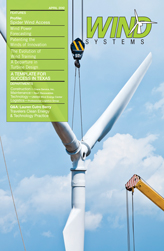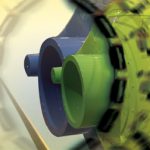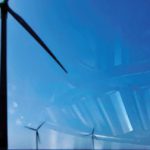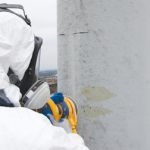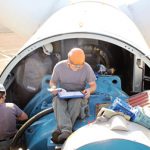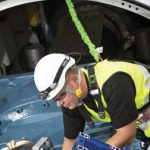As early as 10 years ago, training for wind technicians was informal at best. Learning in the field was a way of life, and just a handful of individuals were responsible for wind turbines from conception to maintenance. In fact, it was often the same engineers who designed the turbines who would install, commission, and even service them. “On the job training literally started at zero,” according to Walter Christmas, a wind energy technology instructor at the Ecotech Institute. “The best hiring managers could do was find people with a technical aptitude and fill in the gaps of their knowledge and skills with ongoing training.”
Having spent time at both Suzlon and Christmas Windpower Services, he has seen firsthand how the industry has changed over time. “Wind companies were extremely lucky if they could find one person with experience in electronics, mechanics, hydraulics, and programmable logic controllers who could also climb a 200-foot tower and work in extreme conditions of heat and cold,” he says. “Needless to say, not everybody is suited for a job as a wind turbine technician. Of course, this means that the supply/demand curves added up to really good wages for a lucky few who found their way toward a career in wind.”
Responding to the need for trained technicians, some strategically located community colleges started grouping previously existing shop classes into a wind turbine technology concentration of study. In fact, turbine manufacturers were known to donate nacelles to be repeatedly torn apart, examined, and reassembled. But this approach wasn’t a fully functioning training process, and industry-trained instructors were often still missing from the educational experience. Five years ago training became more formalized, but it was still primarily conducted in-house by manufacturers or service companies such as the GE Energy Learning Center and Nordex USA, where I gained my passion for and knowledge of wind energy.
From my time with these businesses I was able to see how people from a variety of backgrounds found a place in the wind industry, but with drastically different experience. It made an incredible impact on both the training approach and the time it took to achieve mastery.
Employers’ Demands
So the quandary businesses were stuck with was this: Do employers go with on the job training, which can be slow and costly, or do they seek employees who have gone through school programs, which may lack the hands-on training and industry insight that students need? It soon became apparent that a third option was necessary.
As the wind industry continued to grow, the demand also increased for proper wind training. It became apparent that specific skill sets, courage, professionalism, and a dogged attention to the details were all necessary to complete the job role and a hybrid of classroom education and practical training was necessary to meet employer demand.
Wind energy employers wanted then and continue to demand three things: hands-on, technical training; a deep understanding of theory that allows the ability to troubleshoot on the worksite; and soft skills such as communication and work ethic. This means that companies require employees to be trained through programs that embrace theoretical knowledge and practical training with a complete turbine system. In addition, prime job candidates understand advanced concepts such as variable frequency drives, IGBT frequency converters, fiber optics, programmable logic controllers, and remote SCADA control. Figure 1
“The ability to apply theoretical knowledge in a real-world setting is what separates a wrench-turning technician from a technician who can use training and deductive reasoning skills to diagnose the real issues plaguing a turbine,” Christmas says.
Setting the Standard
The wind energy training and safety labs at Ecotech Institute serve as a showpiece for the campus. The school’s parent company, Education Corporation of America, knew that Ecotech’s success would be contingent on state of the art labs that focus on hands-on learning of the latest industry technology, while incorporating the critical component of safety training.
Ecotech began classes in April 2010 at a temporary location while its permanent facility was built. The school was erected where a vacant building resided, transforming it into a LEED Gold-Certified campus with cutting-edge labs throughout. It opened in January 2011, and the wind labs were continuously upgraded through the end of the calendar year.
“Our labs are a critical piece of the student experience and our narrow focus on renewable energy plays a key role in our success,” says Mike Seifert, president of Ecotech Institute, adding that the first class will graduate in June. “Pair top-notch technology with educators from industry, and we believe that we became the first institute to produce students who will be the best, most prepared employees in the renewable energy sector.”
Ecotech’s recently completed wind energy and safety labs use a wide variety of real-life elements for complete training. The Wind Training Lab contains a double-fed induction generator trainer, fiber optic splicing kit, laser generator alignment lab, borescopes, composite blade repair kit, tap and die sets, bolt extractors, micrometers, torque wrenches, thermographic camera, high voltage tools, oil sampling kit, phase rotation meters, megaohm meter, FLUKE multimeters with insulation testers, a Lab-Volt Wind Turbine Nacelle Trainer, Lab-Volt Wind Turbine Hub Trainer, Lab-Volt Hydraulic Trainers, and several wind farm simulation software packages. The Wind Safety Lab includes a 25-foot climb and rescue tower, Miller Evolution harnesses and lanyards, a Rescue Randy dummy, a Miller Safe Escape rescue device, Lab-Volt cranes and a rigging trainer. Ecotech will soon have a HYTORC brand torque and tensioning trainer, as well.
The integrated systems approach offered by Lab-Volt’s Wind Turbine Training Simulators provide a very realistic view of the functionality and programming of a large, commercial wind turbine. The nacelle and hub trainers were designed by Siemens for Lab-Volt and very closely simulate the operation states of the turbine, which is important in training the controllers and troubleshooting input and output faults. Figure 2
The nacelle is a focal part of Ecotech’s training, equipped with all of the systems of a utility-scale nacelle—yaw, pitch, hydraulics, PLCs, and the vibration, thermal, and environmental sensors that the big turbines use to operate efficiently. There are many mechanical and electrical aspects of the turbine that are important, but understanding how the turbine operates as an automated power plant is the most critical. Once a commissioner or service tech understands how the turbine controller “thinks,” they can troubleshoot it more effectively.
I’m also passionate about the importance of being able to read and interpret electrical schematics, for not only connections, but for function and safety. “The fully operational PLC and SCADA system in our lab allows us to remotely troubleshoot, just like in the industry,” says Auston Van Slyke, another wind energy instructor at Ecotech and former Vestas commissioner. “The most important element is having the functional experience, which allows you to safely start climbing towers and fixing machines on your first day of work.”
Ecotech can take someone with little to no electro-mechanical background and teach him or her the fundamentals of science, physics, math, electronics, electromagnetic theory, power generation, programming PLCs, project management, business, Microsoft Office, and the core skills required by the wind industry. It’s a complete package that many companies have waited a long time to find.
However, expensive technology obviously doesn’t do the teaching itself. Proper curriculum building and industry-leading instructors round out the equation. “Instructors can create real faults in the system that students must diagnose and correct,” Christmas says. “This brings together all of the specialized training they’ve received in their earlier classes.”
Ecotech’s prominent board of advisors was instrumental in creating the curriculum, tapping their own knowledge and a variety of other industry leaders to match up coursework with what employers want in regards to training and daily job demands. Ecotech also recently created a local board of advisors, which allows program directors, like myself, to stay current with the latest industry trends and technologies, while staying agile in changing curriculum according to the newest trends. Represented companies include RES Americas, Alstom Power, NextEra, and Clipper Windpower.
Looking Forward
Wind energy companies are no longer in the position where they simply take eager employees and train them on the job. The wind energy workforce is quickly evolving and relies on targeted and thorough training provided by well-equipped and well-funded training programs.
“Ecotech is training a new generation of technicians who are prepared on day one to assess the general health and efficiency of wind turbines,” says Christmas. “Every time a technician climbs a tower, there is an opportunity to recognize a developing problem with a turbine that can be effectively dealt with before it becomes a costly repair. When Ecotech students join the workforce after the school’s first graduation in June, they will set a new standard by incorporating this value-added approach into their daily work habits.”
Ecotech Institute’s Wind Energy Technology track is a two-year associate’s degree program focused on the generation and transmission of energy using wind power. Designed with employer input, graduates will be prepared to enter the workforce as wind energy technicians. “Soon the manufacturing companies will be closing their own training departments and supporting the development of schools like ours,” Van Slyke predicts.



















